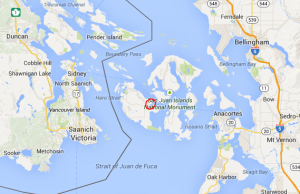
Reporting on the Northwest Developmental Biology Conference - (1)
New readers can follow us on twitter - @homolog_us
Over the last three days, I was immersed at the Northwest Development Biology Conference at the Friday Harbor lab. Readers may not know that the Pacific Northwest region has very large concentration of developmental biologists working on zebrafish. That is no surprise, because the center of zebrafish universe is Monte Westerfield working at University of Oregon. The conference was an wonderful experience and I was possibly the only bioinformatician allowed to enjoy the show. For the benefit of our readers, I will cover what I enjoyed, what I learned and what I did not learn in a series of three commentaries. The first post (this one) presents a set of general observations. The next one will discuss a few interesting talks and a third brief one will mention what was missing. I will also write separate blog posts on a handful of individual topics discussed at the conference.
-———————————————————–
No tweet conference
We have become used to hash-tagged conferences and often the tweets emanating from the conferences are so informative that an online reader can reconstruct major parts of the talks (e.g. check Gene Myers’ dazzler assembler). In contrast, NWDB was twitter-free. That was not as a policy, but because the none of the attendees was interested in tweeting and listening at the same time. I can definitely see the wisdom of Lex Nederbragt’s post in -
Defending no-tweeting/blogging requests at conferences
-———————————————————–
Biochemists apologize
I also noticed that many biochemists apologized (for being biochemists) at the beginning of their talks at this conference and wonder what a bioinformatician/computational biologist would have to do !! This ‘biochemistry vs biology’ distinction brings up Phil Anderson’s More is Difference in my mind. Based on his understanding of ‘broken symmetry’, Anderson discussed that every layer of science added new complexity not easily predictable from the lower layers. For example, particle physicists cannot explain interesting observations in condensed matter physics despite knowing all fundamental laws of nature at the core of condensed matter physics. In the same vein, biochemists understand all molecules in the cell, but that understanding is not enough to explain cell biology.
Irrespective of that, the developmental biology talks from biochemists were quite enjoyable, because they added an extra dimension in their analysis.
-———————————————————–
Beautiful Friday Harbor lab
Let me take a step back and describe my arrival at the conference. For those who do not know, Friday Harbor lab (FHL) is located in an island at the remotest corner of this country. Miss a turn or take the wrong ferry and you will be in Canada (clicking on the image will take you to actual Google map).

This was my first trip to the island and I was disappointed to arrive at the Anacortes Ferry terminal in the middle of a nasty thunderstorm. Thankfully, the sun came out by the time I reached the island and stayed that way for the following three days. After getting down from the Ferry, I decided to walk from the terminal to FHL. People of the island were so nice that at least two cars stopped to ask me where I was going and whether I would need a ride.
I took the second ride from Nicholas Gidmark, a post-doc at FHL, and he dropped me at the main office of the lab. To my surprise, the first person I met there was someone I knew for many years, thanks to doing some good karma in past life :)

Billie Swalla is a well-known marine biologist, who tracks down all kinds of cool animals in the ocean. Her recent genome paper (expect to see in Nature in a few months), along with other papers on ctenophores, will indeed change the biology textbooks and not in an ENCODE way. For readers’s benefit, we wrote a separate blog post on comb jellies and animal evolution.
This year, the first FHL animal to have its entire genome sequenced will be in the limelight because the genome will be published and made available soon.
…….
For years textbooks have started discussion of animals with sponges. They were considered to lack true tissues and had a sessile life style, sitting on the ocean floor as adults and capturing small particles. However, after sequencing the entire genomes of several sponges, it became clear that they are more complex than previously thought. Studies published in 2008 suggested that ctenophores, or comb jellies, were at the base of the animal tree of life, and it became a priority to sequence one of these species. Actually two different species have been sequenced, which is important for comparative purposes. These two comb jelly genomes show remarkable congruence in their genomes and similarities to sponge genomes.
Did I mention that she is also the (interim) director of the Friday Harbor lab?
-———————————————————–
Cultural differences - rural versus urban, Canada vs USA
I already mentioned about people stopping voluntarily and asking whether I would need a ride. That is the part of trustful rural culture I experienced previously, when I drove out of Redmond and accidentally got my car battery down. All techies ignored my plea for help, and only two cars stopping for me were from farmers living in rural areas.
My other observation of difference between Canada and USA is more relevant to academia. Many Canadian researchers from British Columbia and Alberta attended the conference and I noticed that their research labs were less reliant on post-docs. In fact, many labs do not have a single post-docs and they are raising competent and independent graduate students. Another ray of hope is small US colleges like Reed college and Lewis and Clark college, where many good researchers are joining to teach. Their undergraduate students are getting a taste of research life at an early stage of life, when they are ‘foolish enough to fail’ according to Brenner.
-———————————————————–
Everyone is angry about ENCODE
If you read BioMickWatson’s Dear ENCODE. or Sean Eddy’s post-Dan Graur paper (discussed in “Homolog.us Blog Calls for Sean Eddy be Fired for the Sake of Good Science”), you would think that ENCODE was an enormously successful project that made a few ‘missteps’. In reality, it was an unnecessary waste of money. Focusing
During lunch and dinner, many participants commented on ENCODE. Those comments were never made in a positive tone and I was surprised at the awareness. Also, I heard that many other biologists are extremely angry about ENCODE, even though only a handful expressed it publicly like Dan Graur. Those betting their lives on human brain map project should start looking for alternate careers.
-———————————————————–
Junk science of epigenetics
Epigenetics (cells ‘remembering things’ through acetylation and methylation) is junk science or ‘faddish stuff’ as explained by Mark Ptashne. When cells divide, all ‘epigenetic marks’ need to be redrawn and that redrawing can only happen through expressed genes. Therefore, cells can only remember the past through expressed genes, and that differential expression profile gets passed on from mother cells to daughter cells. All that had been explained in the 60s and 70s, and Ptashne’s short introductory book “A Genetic Switch” had been around for over 30 years. Yet, NIH is spending plenty of money on ‘epigenetics’ and ‘epigenomics’ and that makes some scientist look for those ‘marks’ everywhere.
What surprised me at the conference was that many graduate students understood their basic cell biology so well that they clearly explained all points against epigenetics in the same manner as Ptashne. In contrast, when I spoke out against epigenetics in the online bioinformatics community Biostar (Forum: Why Does Biostar Cover Questions on Epigenetics, but not Intelligent Design?), almost everyone objected to my post.
-———————————————————–
Cas9/CRISPR Revolution
On the positive side, several researchers mentioned in private discussions, how revolutionary the new Cas9/CRISPR system has become for genome editing. They are finding the method so easy to use that it could be comparable to the invention of PCR. Previous alternatives like TALEN and ZFN were quite cumbersome. Wikipedia page on CRISPR agrees -
CRISPR simplifies creation of mouse models and reduces the time required to a matter of weeks from months or longer. Knockdown of endogenous genes has been achieved by transfection with a plasmid that contains a CRISPR area with a spacer, which inhibits a target gene. Injecting mouse zygotes with Cas9 and two guide RNAs was able to disable two genes with 80% efficiency. So-called homology-directed repair involves using Cas9 to “nick” DNA, to introduce new gene parts to the zygote.
For those of us working on non-model organisms, cas9/CRISPR is the best hope. Therefore, we wrote a separate short introductory commentary for the benefit of our readers -
Saving Bacteria from Diseases and the Cas9-CRISPR Revolution
-———————————————————–
Core problems for bioinformatics
Those discussions on ENCODE, epigenetics and cas9/CRISPR brings me to the larger field of bioinformatics, which seems to be attracting many intelligent researchers from physics, engineering and computer science. The situation is not too different from the late 1940s, when Schrodinger’s “What is Life” attracted many physicists to life sciences. However, there is one key difference. Schrodinger was an accomplished physicist, who wrote the book to highlight the key scientific problems in biology and motivated others to solve them. Surely, the commercial world benefited hugely from the discoveries, but that was a byproduct of their scientific curiosities. Today’s new entrants are misguided by NIH to solve the wrong set of problems. For example, if you ask bioinformaticians about what the major problems are, they will say - variant calling, alignment, assembly, phylogeny, epigenetics, protein-interaction network, etc. Instead I would suggest bioinformaticians to refocus and consider the following as the key problems in bioinformatics.
1. Understanding the DNA translation machinery.
2. Figuring out the origin of eukaryotic cell.
3. Figuring out the origin of multicellularity.
4. Figuring out the vertebrate and insect body plans.
5. Figuring out the origin of adaptive immune system.
6. Figuring out how sex and reproduction work at the genetic level.
7. Understanding plant body plan and evolution.
I can think of several other problems, but overall I believe it will be more satisfying for bioinformaticians to align themselves with the core problems of biology and then apply their specialized computational skills.